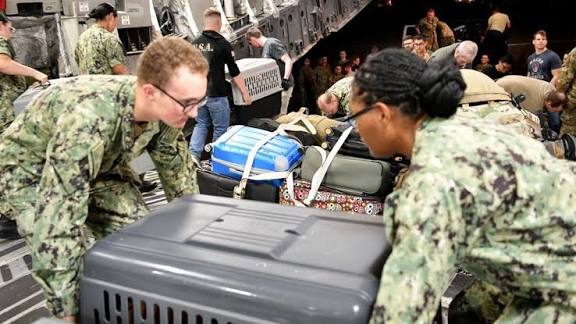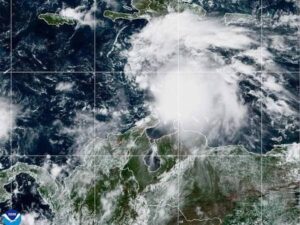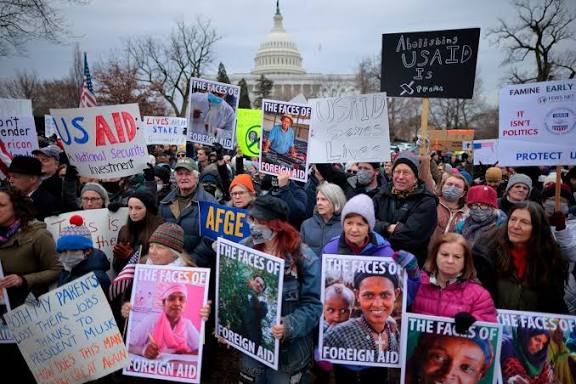Guantanamo bay hurricane melissa: Naval base,Nearly 1,000 staff,Map

More than 4,000 people live on the base, about a quarter of them active-duty sailors and soldiers. Today we will discuss about Guantanamo bay hurricane melissa: Naval base,Nearly 1,000 staff,Map
Guantanamo bay hurricane melissa: Naval base,Nearly 1,000 staff,Map
As Hurricane Melissa roars across the Caribbean, one of the most strategically important U.S. military installations in the world—Guantánamo Bay Naval Base—finds itself directly in the storm’s projected path. Known commonly as “Gitmo,” this base on the southeastern coast of Cuba is home to thousands of military personnel, civilian employees, and their families.
With Hurricane Melissa rapidly intensifying to a Category 4 system and threatening catastrophic flooding and winds exceeding 130 mph, both U.S. and Cuban authorities have launched massive precautionary measures. This article provides an in-depth look at Guantánamo Bay’s geography, its staff and operations, the ongoing evacuation and safety measures, and the possible long-term implications for both the base and the wider region.
1. The Strategic Importance of Guantánamo Bay

Guantánamo Bay is located in southeastern Cuba, occupying a natural harbor that opens onto the Caribbean Sea. The U.S. has leased this land since 1903, using it as a forward operating base for naval operations, intelligence, logistics, and humanitarian missions in the Caribbean.
The naval station spans approximately 45 square miles and serves as a self-contained community. It includes housing areas, schools, medical facilities, and logistical infrastructure, supporting a mix of military, civilian, and contractor personnel.
The base is vital for several reasons:
Strategic maritime location at the entrance to the Windward Passage, a critical chokepoint for international shipping.
Support for U.S. Southern Command operations, particularly counter-narcotics, disaster response, and regional stability missions.
Humanitarian and logistical roles, including potential aid deployment during regional crises in the Caribbean.
Historical and political significance, as it remains the only U.S. military base on Cuban soil.
Because of this unique mix of roles, any major disruption—such as a hurricane—has the potential to affect not just the base itself, but also U.S. military posture and humanitarian readiness across the Caribbean basin.
2. The Rising Threat of Hurricane Melissa
Hurricane Melissa formed in late October over warm Caribbean waters and strengthened rapidly into a Category 4 hurricane. With sustained winds around 220 kilometers per hour (about 135 miles per hour), Melissa has shown characteristics of an intense and compact storm, capable of producing destructive winds, torrential rains, and dangerous storm surge.
Meteorologists warn that Melissa could briefly reach Category 5 intensity before making landfall near eastern Cuba, placing Guantánamo Bay directly within its projected path. Forecast models indicate the potential for storm surge between 10 and 15 feet, accompanied by rainfall exceeding 12 inches in some coastal areas.
For the Guantánamo Bay region, this means:
Violent winds threatening housing and infrastructure.
Heavy rainfall capable of flooding low-lying areas and access roads.
Storm surge likely to inundate coastal zones and pier facilities.
Disruption of power, water, and communications systems.
The Cuban government has declared a state of alert across its eastern provinces, including Guantánamo. Tens of thousands of civilians have been evacuated from at-risk areas.
For the U.S. naval base, the priority has shifted to evacuation of non-essential personnel and the protection of mission-critical infrastructure.
3. Evacuations and Preparations at the Base
The U.S. Navy began evacuating nearly 1,000 people from Guantánamo Bay on October 25 and 26, including families, contractors, and non-essential civilian staff. Many were flown to Naval Air Station Pensacola in Florida, which serves as a temporary safe haven for relocated personnel and their pets.
Base leadership activated comprehensive storm protocols under the Emergency Management Hurricane Condition (HURCON) system. These steps included:
Evacuating families and non-mission essential staff well before the storm’s expected arrival.
Securing all outdoor facilities, such as marinas, recreational fields, and pools.
Reinforcing critical infrastructure, including the hospital, power generation systems, and communication networks.
Stockpiling essential supplies, such as fuel, potable water, food, and medical materials.
Designating hardened shelters for personnel who remain on site.
Local Cuban workers employed at the base were also released early to allow them to secure their own homes and families.
The evacuation effort involved coordination between the U.S. Navy, the Department of Defense, and regional air assets, ensuring that people and animals could be transported safely ahead of deteriorating weather conditions.
4. Guantánamo’s Geography and Vulnerability
The Guantánamo Bay Naval Base occupies both the Windward and Leeward sides of the bay, separated by the deep natural harbor. The base’s two main sections are connected by ferries and a narrow causeway, making cross-bay travel vulnerable to storm surge and rough seas.
Topography and exposure play a critical role in storm resilience:
The Windward side hosts most of the residential housing and family facilities.
The Leeward side contains the airfield and port facilities, critical for resupply and transport.
Much of the coastline sits only a few meters above sea level, increasing exposure to surge and flooding.
Because access to the mainland is restricted and the base’s supply routes are primarily maritime or aerial, any prolonged closure of airfields or docks could isolate the station. This is why early evacuation and self-sufficiency are central to Gitmo’s hurricane planning.
5. Population and Staffing Details
Although the evacuation number of “nearly 1,000” people has circulated widely, the base population is significantly larger.
Under normal conditions, Guantánamo Bay supports approximately 6,000 to 6,500 total personnel, including:
Active-duty military members from various branches.
Department of Defense civilians.
Contractors and local national employees.
Military families, including children attending on-base schools.
This makes Guantánamo Bay one of the most populated and complex overseas installations operated by the U.S. Navy.
Given the scale, full evacuation is not practical. Instead, the base operates on a tiered system: only non-mission essential personnel are relocated, while key operational and emergency response staff remain to ensure mission continuity and base security.
6. The Impact of Hurricane Melissa
When a major hurricane strikes a remote naval base, the potential consequences extend far beyond physical damage.
A. Structural and Infrastructure Damage
High winds can strip roofs, break windows, and topple antennas or light structures. Flooding can damage electrical systems, roads, and housing areas. The combination of saltwater intrusion and rain poses long-term corrosion risks to vehicles and equipment.
B. Power and Water Disruption
If primary generators or desalination plants are compromised, the base could face temporary power outages and water shortages. Backup systems have been tested and secured, but extreme flooding could still affect reliability.
C. Communications Interruption
Satellite and long-range communication systems may be impacted by cloud cover or power loss. Maintaining contact with regional commands and families in the U.S. is a top priority.
D. Logistics and Resupply Challenges
With both the port and the airfield exposed to storm conditions, supply deliveries could be suspended for days. This could delay humanitarian aid shipments and recovery materials.
E. Mission Continuity
Guantánamo Bay serves as a critical logistics and surveillance point in the Caribbean. Even temporary loss of functionality could impact U.S. naval operations, intelligence coordination, and disaster response capabilities in the region.
7. Lessons from Past Storms
Guantánamo Bay has weathered numerous tropical systems over the decades, though not all have been as intense as Hurricane Melissa. Historical experience has shaped the base’s robust preparedness culture.
Key lessons learned include:
Early Evacuation Saves Lives – Moving families and pets before the storm ensures reduced chaos and safer conditions for mission personnel.
Hardened Infrastructure Matters – Buildings constructed to withstand hurricane-force winds dramatically reduce long-term recovery costs.
Redundant Power and Water Systems – Independent generators and desalination plants allow continued operation even if the external grid fails.
Community Coordination – Communication between military and civilian communities, including local Cuban employees, is essential.
Rapid Recovery Planning – Having engineers and logistics teams pre-assigned to damage assessment accelerates post-storm rebuilding.
Because the base operates semi-independently from Cuba, its internal disaster-management systems must be self-reliant, mirroring the capabilities of a small city.
8. The Human Dimension: Families, Pets, and Morale
While hurricane planning often focuses on infrastructure, the human aspect is just as critical. For families stationed at Guantánamo Bay, evacuation is both a logistical challenge and an emotional strain.
Many families were separated from their service members, with spouses and children evacuated to Florida while mission personnel stayed behind. Temporary housing at U.S. facilities on the mainland ensures their safety but also introduces uncertainty and stress.
Pet evacuation was another logistical hurdle. The base made arrangements for transport aircraft to carry hundreds of animals, emphasizing the U.S. military’s commitment to supporting family welfare even under extreme conditions.
Meanwhile, those remaining on base—security, maintenance, and emergency crews—face long, intense hours before and after the storm. Maintaining morale through communication, leadership, and teamwork is a vital part of Gitmo’s hurricane readiness culture.
9. Coordination Between the U.S. and Cuba
Although Guantánamo Bay operates under U.S. control, it is geographically embedded within Cuba, which presents unique coordination challenges during natural disasters.
Cuba’s Civil Defense authorities monitor and respond to the same storms that threaten the base. In times of severe weather, informal communication channels between U.S. base officials and Cuban counterparts are sometimes activated to share meteorological data and ensure mutual safety.
Both sides recognize that hurricanes are non-political threats, and regional coordination—however limited—is in everyone’s interest. The evacuation of local Cuban workers from the base area was synchronized with the island’s wider emergency response, underscoring the practical cooperation that can emerge during crises.
10. Potential Aftermath and Recovery
Once Hurricane Melissa passes, the recovery phase will begin immediately. Initial efforts will focus on:
Damage assessment across housing, airfields, piers, and utilities.
Clearing debris from runways and roads to restore internal mobility.
Reestablishing communications with U.S. Southern Command and supply hubs.
Restoring essential services such as power, water, and waste management.
Welcoming back evacuated families once safety is confirmed.
Long-term recovery will depend on the extent of the damage. If infrastructure such as the airfield or desalination plant suffers major impacts, the base may operate on reduced capacity for weeks.
However, Guantánamo Bay’s resilience systems—including hardened shelters, stored resources, and experienced emergency management teams—make it one of the most disaster-ready installations in the U.S. Navy’s global network.
11. Broader Implications of Hurricane Melissa
The consequences of Melissa go beyond Guantánamo Bay. The hurricane threatens to inflict widespread damage across Jamaica, Haiti, and eastern Cuba—regions already vulnerable due to infrastructure challenges and recent rainfall.
In the days following the storm, the naval base could serve as a staging point for humanitarian aid operations. If facilities remain intact, Guantánamo Bay might provide a vital logistics hub for delivering relief supplies and coordinating disaster-response missions throughout the Caribbean.
This dual role—both as a military installation and a potential humanitarian platform—illustrates why maintaining resilience at Guantánamo Bay is not merely a matter of U.S. defense strategy, but also of regional humanitarian security.
12. Future of Resilience and Climate Adaptation
The increasing frequency and intensity of hurricanes in the Caribbean raises serious questions about long-term resilience for U.S. military installations. Guantánamo Bay’s experience with Hurricane Melissa will likely drive new discussions about:
Stronger building standards to withstand Category 5 wind loads.
Expanded seawall and drainage systems to mitigate flooding.
Investment in renewable micro-grids for energy resilience.
Improved data-sharing with regional meteorological centers.
Psychological support and family-readiness programs for future evacuations.
The lessons learned from Melissa could set a precedent for how other U.S. bases—both domestic and overseas—plan for severe weather events in an era of intensifying climate risks.
Conclusion
Hurricane Melissa’s approach to Guantánamo Bay represents one of the most serious natural threats the base has faced in recent years. With winds exceeding 130 mph and the potential for catastrophic flooding, the U.S. Navy’s rapid evacuation of nearly 1,000 people and the hardening of its facilities reflect an experienced and well-rehearsed emergency protocol.
While much depends on the storm’s final track, the situation highlights several truths: preparedness saves lives, resilience protects missions, and cooperation—both within the military and with regional authorities—can mitigate even the most powerful forces of nature.
In the end, Guantánamo Bay’s story is one of discipline, foresight, and adaptation. Whether as a strategic naval hub or as a community under threat, Gitmo stands as a testament to how human planning and courage can stand up to the raw power of the elements.
How useful was this post?
Click on a star to rate it!
Average rating 0 / 5. Vote count: 0
No votes so far! Be the first to rate this post.
About the Author
usa5911.com
Administrator
Hi, I’m Gurdeep Singh, a professional content writer from India with over 3 years of experience in the field. I specialize in covering U.S. politics, delivering timely and engaging content tailored specifically for an American audience. Along with my dedicated team, we track and report on all the latest political trends, news, and in-depth analysis shaping the United States today. Our goal is to provide clear, factual, and compelling content that keeps readers informed and engaged with the ever-changing political landscape.




